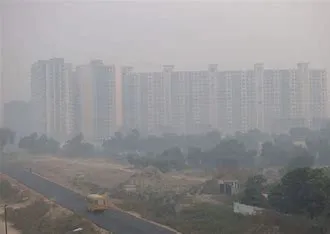The air quality in Delhi has recently deteriorated to dangerously high levels. To address this issue swiftly and effectively, the Commission for Air Quality Management (CAQM) has implemented Stage 4 of the Graded Response Action Plan (GRAP). This stage involves measures such as restricting bus services, pausing construction work and mining activities, and transitioning primary school classes to online learning. Although these steps are crucial in addressing the current pollution issue promptly, they alone cannot effectively address the underlying factors contributing to air pollution in the long term.
It is crucial to prioritize short-term solutions for relief; however, we must not overlook the factors that contribute to pollution in the long term as well. One significant factor is the dust produced during construction activities. While the temporary suspension of construction operations following GRAP guidelines is a move in the right direction, it also underscores the urgency of implementing more environmentally friendly building methods. Germany and Sweden serve as examples of nations that have successfully implemented construction practices. For instance, Germany prioritizes the use of low-carbon concrete, whereas Sweden focuses on promoting energy-efficient structures with improved insulation and solar innovations. India has the opportunity to implement strategies to minimize dust and emissions from construction activities and promote sustainable development.
The need for transformation in transportation is crucial to address the issue of pollution in Delhi caused by road dust and vehicle emissions. Although the metro system has advanced to some extent in Delhi, there are still areas with connectivity that need attention. Expanding the metro network and integrating buses can lead to a decrease in private car usage. Moreover, promoting the adoption of electric vehicles (EVs) could play a role in reducing emissions. Providing benefits such as tax incentives, toll discounts, and even offering parking for EVs could potentially increase their attractiveness to commuters.
Biking is becoming more popular as an eco-friendly option in Delhi; however, the city’s infrastructure doesn’t fully support it yet. Although smart bikes are being introduced in some areas, which is a move forward, the absence of marked biking lanes and safety precautions deters many people from biking. Cities such as Copenhagen and Amsterdam serve as models for incorporating biking into urban environments. Delhi could take inspiration from their approach by investing in infrastructure for cyclists, such as bike lanes and bike-sharing services, to enhance the safety and convenience of cycling for its residents.
Encouraging the use of sustainable building methods is crucial too! Providing incentives for individuals who build energy-efficient houses or utilize eco-friendly materials could greatly support sustainability efforts in communities worldwide. Numerous nations offer tax advantages or financial aid to developers who embrace green building strategies. India could introduce perks like discounts on energy-saving devices, offers on solar panel setups, or financial assistance for homeowners undertaking eco-conscious improvements. These initiatives would not only lessen the burden on energy reserves but also encourage environmentally responsible construction practices.
Another helpful way to decrease the number of cars on the road is through carpooling initiatives, such as carpool lanes and discounts for vehicles with passengers, which have proven effective in countries around the world. Introducing strategies in Delhi, such as designated carpool lanes or toll reductions for cars carrying two or more passengers, could play a role in alleviating traffic congestion and decreasing harmful emissions levels. By implementing these measures, not only would pollution be reduced, but it would also enhance the daily commute experience for numerous residents in the area.
The call for action is critical now. The air pollution crisis in NCR intensified on November 17, 2024, as Delhi’s average Air Quality Index (AQI) climbed to a hazardous 441 by 4 PM, classified as ‘severe,’ up from 419 the previous day. The findings from studies conducted by institutions like IIT Kanpur indicate that road dust and vehicle emissions play a role in causing pollution in the city. These harmful pollutants are linked to health concerns, such as respiratory illnesses and cardiovascular diseases. The Stage 4 actions outlined in the GRAP are crucial for providing relief; however, it is evident that a comprehensive long-term plan is essential to enhance the air quality in Delhi. By emphasizing the enhancement of public transportation services, implementing infrastructure for cyclists, advocating for eco-friendly construction methods, and encouraging carpooling, Delhi can strive to diminish pollution levels and establish a healthier and more sustainable environment for all residents.
The author is Humanitarian and Development Professional























